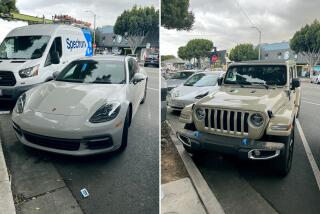German Car Colors Get the Royal Treatment : Technology: A breakthrough allows two makers to offer cars painted in the radiant blue of lapis lazuli.
FRANKFURT, Germany — German automobile makers Daimler-Benz AG and BMW now have cars fit for kings--models painted for the first time in the exclusive royal blue of the lapis lazuli stone.
The two cars, lacquered in this most blue-blooded of hues, were to make their premiere drive in Heidelberg, Germany, at a presentation timed to coincide with the Frankfurt International Car Show earlier this month.
Until now, lapis lazuli, a radiant blue stone shot through with shimmers of gold, had always defied attempts to reproduce the color in large amounts.
Traditionally, the color is won from lapis lazuli stone particles mixed with hot beeswax, resin, and oil. After soaking in water for 30 days, the mix is kneaded until small amounts of the desired pigment filter into the water.
But extracting the color by this method would have made painting one single car a Herculean task until Peter Mack, a 56-year-old goldsmith and designer from Neckargemuend, Germany, ended his 15-year quest for a cheap production method.
The color that resulted from his adventure has a quality so true that not only deluxe cars, but soon also elegant pens will bear the color that has symbolized wealth and exclusivity since the times of ancient Egypt.
Mack said that both U.S. writing implements group Cross and Montblanc have plans to decorate their pens with the blue from his Swiss firm Lapis Diffusion SA.
For Mack, the profit from this is but a means to help him achieve his life’s work--producing an exact replica of the lavish 16th-Century Koran of Sultan Selim II for which he first needed large quantities of the brilliant hue.
In 1979, Mack had won acclaim for reproducing a stunningly accurate facsimile of the leather binding of the Song of Roland, a feat that made him the toast of the Stuttgart exhibit and that persuaded him to undertake the Koran project.
He won the copyright for the 666-page, 40-pound work of art from the Stiftung Preussischer Kulturbesitz.
Mack wanted to prepare 2,000 copies of the Koran for about 50,000 Swiss francs ($40,860) each. Because Islam forbids the making of money from religious symbols, a nonprofit organization was to take over the sales.
At first, everything seemed to work. Financing was found. The chemists at BASF AG and the metallurgical experts from Degussa reproduced, after meticulous experiments, the organic Koran colors and a warm red-gold.
The firm Louisenthal GmbH of Tegernsee, which specializes in the manufacture of falsification-safe bank notes, remade the paper.
But then the project appeared on the verge of failure because of one seemingly impossible hurdle: Mack could not find a way to get sufficient quantities of the lapis lazuli blue that was so generously used in the Koran.
To extract 880 pounds by the traditional method was hopeless. By using that process the pigment won was sufficient to finish just one reproduction.
But then Mack found in the KHD subsidiary Ekof GmbH and its chief Hans Stahl a partner who managed the breakthrough in the extraction of the ultramarine blue for 30,000 German marks ($20,170) a liter.
With the help of Hoechst subsidiary Herberts Standox, Mack also managed to develop a special technique to contain loss of the pigment as it is applied.
But the profit the car and pen prospects are likely to give Mack are but a means to an end. For a car, each lacquer job costs between 6,000 and 10,000 marks ($4,034 and $6,724).
“I have to make money to finally realize my Koran project,” Mack said.




